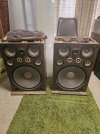I have a pair of vintage JVC SK15A speakers that I picked up for $20. I was using them for about a year, 2 years ago, but the boxes are a little swollen from moisture damage, they were previously mothballed in someone's garage for a couple of decades.
The drivers are fine and perform exceptionally well, hence my idea to rebuild the boxes, into a more modern design.
I've had experience in past of building and designing speakers from driver values. This project won't require any of those calculations.
I have two options, rebuild same spec (volume and dimensions), so they are close as possible to the original, with a modern touch.
Or, my preference is to have a narrow/deep enclosure, with a side firing woofer and have the mid tweeter array flipped to the vertical.
Questions to the folk with much more knowledge than me - will this affect the original design at all? Will crossovers need to be redone? Baffle considerations?
Boxes are currently ~600x420x290 (external).
I want to rotate that to ~250x450x1200 (external)
Keeping the original box volume and mid tweeter placement as is, just vertical. Extra height will be used for a base filled with weight.
I'll be using 25mm MDF, as I have 3 sheets of 900x1800 on hand (office partitions, repurposed, they cost me $5 each and weight a ton)
Thoughts/advice?
Cheers
Adam
The drivers are fine and perform exceptionally well, hence my idea to rebuild the boxes, into a more modern design.
I've had experience in past of building and designing speakers from driver values. This project won't require any of those calculations.
I have two options, rebuild same spec (volume and dimensions), so they are close as possible to the original, with a modern touch.
Or, my preference is to have a narrow/deep enclosure, with a side firing woofer and have the mid tweeter array flipped to the vertical.
Questions to the folk with much more knowledge than me - will this affect the original design at all? Will crossovers need to be redone? Baffle considerations?
Boxes are currently ~600x420x290 (external).
I want to rotate that to ~250x450x1200 (external)
Keeping the original box volume and mid tweeter placement as is, just vertical. Extra height will be used for a base filled with weight.
I'll be using 25mm MDF, as I have 3 sheets of 900x1800 on hand (office partitions, repurposed, they cost me $5 each and weight a ton)
Thoughts/advice?
Cheers
Adam
